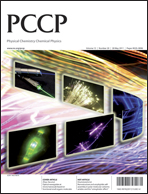Quantifying the anisotropy of intermolecular potential energy surfaces: a critical assessment of available N2–N2 potentials†
Abstract
Based on definition of angular central moments, a quantitative measure is proposed for comparative assessment of the anisotropy of different intermolecular potential energy surfaces at different intermolecular distances. Angular spreadness, skewness and peakedness are three features of anisotropy that are used here to describe the distribution of values of interaction energy around its isotropic component. In agreement with qualitative interpretations, the proposed measure exhibits a sharp change in the R-dependent pattern of anisotropy at an intermediate distance where the repulsive forces on the average overcome the attractive ones. The R-dependence of anisotropy of available N2–N2 potentials is examined in comparison with bare ab initio data and considerable discrepancies are found at distances shorter than the onset of repulsion. It is shown that the full experimentally derived potentials with simplified functional forms do not reproduce the correct anisotropy of interaction energy.


 Please wait while we load your content...
Please wait while we load your content...